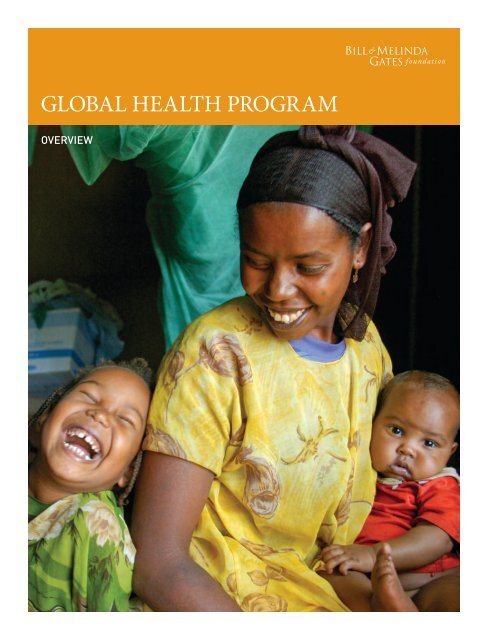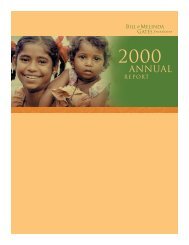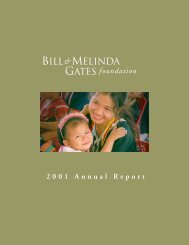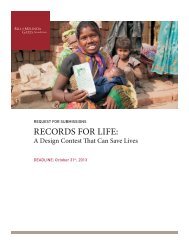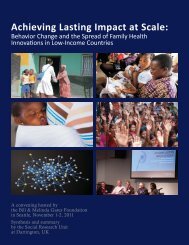Global Health Program Overview - Bill & Melinda Gates Foundation
Global Health Program Overview - Bill & Melinda Gates Foundation
Global Health Program Overview - Bill & Melinda Gates Foundation
Create successful ePaper yourself
Turn your PDF publications into a flip-book with our unique Google optimized e-Paper software.
GLOBAL HEALTH PROGRAM<br />
OVERVIEW
TABLE OF CONTENTS<br />
Letter from Tachi Yamada 1<br />
The State of <strong>Global</strong> <strong>Health</strong>: 2<br />
Recent Progress and the Road Ahead<br />
Life-saving Progress in <strong>Health</strong> 2<br />
Unprecedented Opportunity to Do More 3<br />
Our <strong>Global</strong> <strong>Health</strong> Strategy 4<br />
Our Approach 4<br />
Priority Diseases and Conditions 5<br />
Building Partnerships 6<br />
<strong>Global</strong> <strong>Health</strong> <strong>Program</strong> Areas 7<br />
Enteric and Diarrheal Diseases 7<br />
Family Planning 8<br />
Dr. Tachi Yamada (president, <strong>Global</strong> <strong>Health</strong> <strong>Program</strong>, <strong>Bill</strong> & <strong>Melinda</strong> <strong>Gates</strong> <strong>Foundation</strong>) holds a boy who received<br />
a polio vaccine at the Nizamuddin railway station (New Delhi, India, 2009).<br />
ON THE COVER: A mom with her children, under mosquito nets (Harar, Ethiopia, 2005).<br />
HIV 8<br />
Malaria 9<br />
Maternal, Neonatal, and Child <strong>Health</strong> 10<br />
Neglected and Other Infectious Diseases 10<br />
Nutrition 11<br />
Pneumonia 12<br />
Polio 13<br />
Tobacco 13<br />
Tuberculosis 14<br />
<strong>Global</strong> <strong>Health</strong> Discovery 15<br />
<strong>Global</strong> <strong>Health</strong> Delivery 16<br />
<strong>Global</strong> <strong>Health</strong> Policy and Advocacy 17<br />
Commitment to Learning 18
THE GLOBAL HEALTH<br />
PROGRAM AIMS TO HARNESS<br />
ADVANCES IN SCIENCE AND<br />
TECHNOLOGY TO SAVE LIVES<br />
IN DEVELOPING COUNTRIES.<br />
We are entering a new era of global health. The world is taking unprecedented action<br />
to fight deadly diseases and improve health in developing countries. With new funding,<br />
new attention, and new technologies, we are witnessing remarkable progress around the world.<br />
For me, one of the most vivid images of progress comes from a trip to Zanzibar, Tanzania,<br />
where aggressive malaria-control efforts are under way. While there, I toured a pediatric ward<br />
that for years had been filled with children dying of malaria. But on this visit, I was amazed to<br />
see the ward empty—a small but powerful sign of hope in the fight against an age-old disease.<br />
Success stories in health are becoming increasingly common throughout the developing world.<br />
In the coming years, we will have a tremendous opportunity to make even greater gains—by<br />
delivering health solutions already at our disposal and applying scientific innovation to discover<br />
new vaccines, drugs, and other tools.<br />
<strong>Bill</strong> and <strong>Melinda</strong> <strong>Gates</strong> have made global health a priority for the foundation because they’ve<br />
seen firsthand the impact health advances can have in developing countries. Guided by their<br />
vision, we are committed to making a unique and lasting contribution to the health of the<br />
world’s poorest people.<br />
The <strong>Global</strong> <strong>Health</strong> <strong>Program</strong> has grown and evolved significantly in recent years. I hope<br />
this document provides a helpful overview of our goals, priorities, and strategy.<br />
Tachi Yamada, M.D.<br />
President, <strong>Global</strong> <strong>Health</strong> <strong>Program</strong><br />
www.gatesfoundation.org 1
THE STATE OF GLOBAL HEALTH:<br />
Recent Progress and the Road Ahead<br />
A woman and her child at the Matela Village Dispensary (Mwanza, Tanzania, 2009).<br />
2 The State of <strong>Global</strong> <strong>Health</strong><br />
LIFE-SAVING PROGRESS IN HEALTH<br />
The progress we’re making today in global health was<br />
unthinkable a generation ago. During much of the last<br />
century, major health advances occurred primarily in<br />
wealthy countries. Diseases that have been defeated<br />
in wealthy nations, however, continue to sicken and<br />
kill people in the developing world.<br />
In recent years, global health has begun to receive the<br />
attention it deserves. Thanks to major new investments<br />
from governments, private companies, charities, and<br />
concerned individuals, the health of those in the developing<br />
world is now receiving more funding and attention than<br />
at any other point in history.<br />
New investments in global health are achieving<br />
extraordinary results:<br />
• <strong>Program</strong>s to deliver childhood vaccines have pushed basic<br />
immunization rates to all-time highs.<br />
• Polio cases have declined 99 percent in the past 20 years—<br />
and the world now has the opportunity to get rid of the<br />
disease completely.<br />
• The number of people receiving treatment for HIV<br />
infection has increased tenfold in just five years.<br />
• Since 2000, aggressive control has helped reduce malaria<br />
cases and related deaths by up to half in 25 countries.<br />
• The number of children who die before age 5—a crucial<br />
indicator of a society’s overall health—has fallen every<br />
year for the past few decades and is now less than 9 million<br />
worldwide, about half of what it was in 1960.<br />
Research focused on the needs of countries in the developing<br />
world has also increased substantially after decades of neglect.<br />
For example, new vaccines against meningitis, cholera, and<br />
typhoid could soon become available for use. Other important<br />
new vaccines are entering late-stage clinical trials.
UNPRECEDENTED OPPORTUNITY<br />
TO DO MORE<br />
In the coming years, the world will have an unprecedented<br />
opportunity to build on recent progress in global health.<br />
Effective vaccines, drugs, and other solutions are available to<br />
fight many of the developing world’s most serious diseases.<br />
By delivering these remedies quickly to more people in need,<br />
we can save millions more lives.<br />
<strong>Health</strong> experts at Johns Hopkins University, for example,<br />
estimate it is possible to reduce the number of young children<br />
who die to 5 million annually by 2025. We can achieve this<br />
goal simply by expanding existing vaccines, effective malaria<br />
control, proper newborn care, and prompt treatment for<br />
severe pneumonia and diarrhea.<br />
But today’s solutions are just a starting point. At the<br />
foundation, we are passionate about the potential for<br />
innovation to transform global health at every level.<br />
Innovation in basic science may lead to big breakthroughs,<br />
but equally important is innovation in how we deliver<br />
affordable and effective health tools to those who need them.<br />
Reducing Annual Deaths Among Children Under Age 5<br />
Child deaths<br />
(in millions)<br />
20<br />
15<br />
10<br />
5<br />
0<br />
A scientist conducts research at the National TB Reference Laboratory<br />
(Lusaka, Zambia, 2009).<br />
1960 1965 1970 1975 1980 1985 1990 1995 2000 2005 2010 2015 2020 2025<br />
NO NEW INVESTMENT<br />
9,300,000 CHILD DEATHS<br />
4,000,000<br />
LIVES SAVED EACH YEAR BY 2025<br />
5,000,000 CHILD DEATHS<br />
WITH INVESTMENTS IN VACCINES,<br />
MALARIA NETS AND DRUGS,<br />
IMPROVED CARE FOR NEWBORNS,<br />
AND BETTER ACCESS TO DIARRHEA<br />
AND PNEUMONIA TREATMENTS<br />
The annual number of children who die before age 5 has fallen to half of what it was in 1960. With continued efforts, we can reduce that number<br />
by half again by 2025.<br />
Sources: 1960: UNICEF; 1965–1985: IHME, University of Washington; 1990–2008: UNICEF/WHO<br />
www.gatesfoundation.org 3
OUR GLOBAL HEALTH STRATEGY<br />
The foundation has invested more than $13 billion (U.S.) in<br />
global health since 1994, which represents about 60 percent<br />
of our total giving to date. We invest in health because of the<br />
tremendous opportunity it offers to make a difference in the<br />
lives of millions of people.<br />
At the same time, we’re only one part of the global health<br />
picture. Our resources are small compared to the world’s<br />
overall needs and compared to those of donor countries.<br />
We look for ways to have a unique and lasting impact.<br />
OUR APPROACH<br />
Science and technology offer incredible potential to improve<br />
health in developing countries. We support efforts to discover,<br />
develop, and deliver practical, affordable vaccines, medicines,<br />
and other health tools that will have the greatest long-term<br />
benefits for the greatest number of people.<br />
Our number one global health priority is creating and<br />
delivering vaccines for infectious diseases. Millions of lives<br />
can be saved in developing countries by ensuring access to<br />
effective vaccines that already exist and by developing new<br />
vaccines for use.<br />
Our global health strategy reflects our unique role as a private<br />
foundation. This means we can pursue high-risk, high-reward<br />
projects and promising new ideas. We also have the flexibility<br />
to quickly take advantage of emerging opportunities. At the<br />
same time, we can make long-term investments and stay<br />
focused even in the face of difficult setbacks.<br />
We partner with organizations around the world to address<br />
our priority diseases and health conditions.<br />
Accelerating Discovery and Development<br />
We work to discover and develop urgently needed global<br />
health advances, including new vaccines and other prevention<br />
tools, new drugs and treatment strategies, and improved<br />
diagnostics. We support research and development activities<br />
from early-stage discovery to late-stage clinical trials.<br />
Delivering <strong>Health</strong> Solutions<br />
We support efforts to implement new and underused vaccines<br />
and other tools, demonstrate their real-world impact, and<br />
enable their widespread adoption. For example, we support<br />
the GAVI Alliance to expand childhood immunization. We<br />
also invest in programs in India and China to demonstrate<br />
effective approaches to HIV prevention among people at<br />
risk of infection.<br />
4 Our <strong>Global</strong> <strong>Health</strong> Strategy<br />
Dr. Tokugha attends to an HIV-positive patient at the Y.R. Gaitonde Centre<br />
for AIDS Research and Education (YRG CARE) (Chennai, India, 2008).<br />
Advocating for Resources and Policies<br />
We work to encourage increased resources and improved<br />
public policies for global health. This includes collecting<br />
data and evidence on health needs and solutions, promoting<br />
awareness of effective approaches, and building political<br />
commitment to global health among donors and in<br />
developing countries.
PRIORITY DISEASES AND CONDITIONS<br />
Our global health strategy focuses on diseases and health<br />
conditions that account for a significant share of illness and<br />
death in developing countries. However, we take into account<br />
more than disease burden alone. We also attempt to address<br />
historically neglected or underfunded health problems and<br />
apply our resources in places where they could lead to major<br />
health advances.<br />
With these considerations in mind, we focus on the<br />
following areas:<br />
• infectious diseases—including diarrheal diseases,<br />
HIV/AIDS, malaria, neglected diseases, pneumonia, polio<br />
and other vaccine-preventable diseases, and tuberculosis<br />
• family health—including the leading causes of illness and<br />
death for mothers and newborns during and immediately<br />
after childbirth; nutrition, especially during the first two<br />
years of life; and family planning<br />
Causes of Death for Children Under Age 5<br />
42%<br />
Neonatal<br />
8%<br />
Malaria<br />
10%<br />
19%<br />
Other<br />
5%<br />
5%<br />
Diarrhea<br />
(non-rotavirus)<br />
Total deaths under age 5 = 8.8 million in 2008<br />
Pneumonia<br />
(Pneumococcus)<br />
Pneumonia<br />
(non-Pneumococcus)<br />
8%<br />
Diarrhea<br />
(rotavirus)<br />
2% AIDS<br />
1% Measles<br />
Child <strong>Health</strong> Epidemiology Reference Group of WHO and UNICEF.<br />
Source: WHO and UNICEF<br />
Cristela Rugama, with her baby Jarin Ruiz, waits with other mothers for the arrival of the life-saving vaccine that will protect their children against rotavirus<br />
(Pantasma, Nicaragua, 2009).<br />
www.gatesfoundation.org 5
OUR GLOBAL HEALTH<br />
STRATEGY<br />
BUILDING PARTNERSHIPS<br />
Achieving lasting change in health requires bringing together<br />
diverse groups, each with a critical role to play, including<br />
governments, private companies, research institutes, and<br />
international and community organizations. Much of our<br />
work involves building and strengthening partnerships<br />
with organizations around the world.<br />
Public-Private Partnerships<br />
Many of our grants support partnerships between the public<br />
and private sectors to collaborate on critical health goals.<br />
For example, we support the efforts of the <strong>Global</strong> Alliance<br />
for Improved Nutrition (GAIN) to produce and deliver<br />
nutritious food. We also support a number of product-<br />
development partnerships that bring together the unique<br />
talents and resources of industry, academia, and the public<br />
sector to create affordable new health tools tailored to<br />
the needs of developing countries.<br />
<strong>Global</strong> Collaborations<br />
In some cases, our largest grantees directly fund a wide range<br />
of smaller partners around the world, including organizations<br />
in developing countries. For example, we have provided<br />
significant support to the Malaria Vaccine Initiative, which in<br />
turn supports malaria researchers throughout Europe and the<br />
United States and in seven African countries. This approach<br />
allows us to make grants quickly and efficiently and to<br />
leverage our partners’ expertise, resources, and relationships.<br />
Coordination with Other Funders<br />
We look for opportunities to pool resources with other<br />
global health funders. We invest in international initiatives<br />
such as the GAVI Alliance and the <strong>Global</strong> Fund to Fight<br />
AIDS, Tuberculosis and Malaria because they are able to<br />
raise funding from multiple donors, minimize operational<br />
costs through centralized management, and conduct regular<br />
monitoring and evaluation to ensure funds are spent on<br />
effective programs.<br />
6 Our <strong>Global</strong> <strong>Health</strong> Strategy<br />
“Investing in global health is one of the smartest investments we can make. Saving and<br />
improving millions of lives will be one of the greatest things humanity has ever done.”<br />
—<strong>Melinda</strong> French <strong>Gates</strong><br />
co-chair, <strong>Bill</strong> & <strong>Melinda</strong> <strong>Gates</strong> <strong>Foundation</strong><br />
A mother and son looking after her HIV-positive husband in the hospital<br />
(Ukhrul, Manipur, India, 2007).<br />
We also work with other funders to establish creative new<br />
funding approaches. For example, along with the governments<br />
of Canada, Italy, Norway, Russia, and the United Kingdom, we<br />
support the Advance Market Commitment, an effort to create<br />
predictable markets for new vaccines against pneumococcal<br />
disease, a leading killer of young children in poor countries.<br />
Detailed strategies guide our grantmaking and other<br />
activities in each of our global-health program areas.<br />
Following are brief summaries of each area.<br />
TO LEARN MORE<br />
www.gatesfoundation.org/ghstrategies
GLOBAL HEALTH PROGRAM AREAS:<br />
Diseases and Conditions<br />
ENTERIC AND DIARRHEAL DISEASES<br />
The global situation: While diarrhea-related deaths<br />
have decreased globally due to improvements in antibiotics,<br />
vaccines, oral-rehydration therapy, income, and water and<br />
sanitation, diarrheal diseases remain the second-leading<br />
cause of childhood death. Each year, diarrhea causes more<br />
than 1.7 million deaths in children under 5—nearly all of<br />
whom live in the lowest-income areas. Those who survive<br />
diarrheal infections often have other health problems and<br />
reduced cognitive development, potentially causing<br />
lifelong impairment.<br />
Our strategy: We aim to save and improve millions of<br />
lives through the development and delivery of low-cost<br />
interventions that prevent diarrheal diseases (through<br />
hygiene, breastfeeding, and vaccines) and treat them<br />
(through oral-rehydration and zinc therapies). In the long<br />
term, we want to protect children in developing countries<br />
from diarrhea and effectively treat them at the same rate<br />
as children in developed countries.<br />
Key elements of our strategy include:<br />
• developing and introducing safe, effective, affordable vaccines<br />
to prevent major causes of diarrhea in developing countries,<br />
including rotavirus, cholera, typhoid, Escherichia coli,<br />
and Shigella<br />
• improving understanding of diarrhea and its links to<br />
nutrition and poor immunity, to speed development of<br />
new vaccines and therapeutics<br />
• assessing the role of diagnostics and the biology of infections,<br />
to guide the development of improved therapies<br />
• promoting access to and delivery of existing therapies, such<br />
as oral-rehydration salts (ORS) and zinc, and developing<br />
improved therapies to counter diarrhea-related dehydration<br />
and promote better outcomes<br />
• promoting effective practices, such as breastfeeding,<br />
improved nutrition, and improved sanitation and hygiene<br />
<strong>Global</strong> <strong>Health</strong> <strong>Program</strong> Areas<br />
Young baby receives the rotavirus vaccine at the Pantasma <strong>Health</strong> Center<br />
(Pantasma, Nicaragua, 2009).<br />
TO LEARN MORE<br />
www.gatesfoundation.org/diarrhea<br />
www.gatesfoundation.org 7
GLOBAL HEALTH<br />
PROGRAM AREAS<br />
FAMILY PLANNING<br />
The global situation: In recent years the reproductive<br />
health of men and women in the developing world has<br />
improved tremendously, and family-planning services have<br />
been greatly expanded for those who want them. Family<br />
planning is a cost-effective way to save and improve the lives<br />
of women and children and empower families to determine<br />
the optimal timing and spacing of births.<br />
Our strategy: We aim to improve health by increasing<br />
access to high-quality, voluntary family-planning services<br />
and contraceptives in developing countries. We work at a<br />
global level and in priority countries to increase access<br />
to family-planning services.<br />
Key elements of our strategy include:<br />
• advocating for increased resources and effective policies,<br />
including better procurement systems and increased supply<br />
of and access to contraceptives<br />
• demonstrating the impact of family-planning programs that<br />
promote contraceptive awareness and use in poor urban<br />
areas of the developing world<br />
• developing new contraceptive methods that are easy to<br />
use, cost-effective, and appropriate for women and men<br />
in poor countries<br />
HIV<br />
The global situation: As the world makes significant<br />
progress in treating people living with HIV/AIDS, it is<br />
also critical that we accelerate progress in preventing new<br />
infections. For every two people who receive HIV treatment<br />
today, another five become newly infected with the virus.<br />
There is tremendous opportunity to reduce HIV infections<br />
with existing tools. Making use of all currently available<br />
prevention strategies—such as condoms, education, and<br />
harm-reduction programs—could prevent more than half<br />
of the infections projected to occur over the next decade.<br />
The successful development of drugs, vaccines, and other<br />
new preventive measures could reduce infections even more.<br />
Our strategy: Our HIV strategy aims to reduce new HIV<br />
infections significantly in developing countries by delivering<br />
proven prevention tools and strategies, as well as advancing<br />
research and development on new prevention technologies.<br />
8 <strong>Global</strong> <strong>Health</strong> <strong>Program</strong> Areas<br />
A pregnant woman receives guidance from Saru Auji, a female community health<br />
volunteer (Kalena, Doti District, Nepal, 2009).<br />
TO LEARN MORE<br />
www.gatesfoundation.org/familyplanning<br />
Key elements of our strategy include:<br />
• overcoming key scientific challenges to developing safe and<br />
effective HIV vaccines and advancing promising vaccines<br />
to clinical trials<br />
• accelerating research on drugs and other interventions<br />
that can help prevent HIV, and enhancing the safety and<br />
effectiveness of male circumcision for HIV prevention<br />
• demonstrating what works in HIV prevention by supporting<br />
programs that deliver services to groups at the greatest risk<br />
• advocating for continued resources to fight HIV/AIDS, and<br />
helping ensure that resources are used as effectively and<br />
efficiently as possible<br />
TO LEARN MORE<br />
www.gatesfoundation.org/HIV
MALARIA<br />
The global situation: Thanks to a global push to control<br />
malaria, the malaria burden since 2000 has declined by at<br />
least half in 25 countries around the world. Progress is also<br />
being made on the scientific front; new tools for controlling<br />
the disease, including a potential vaccine to prevent malaria<br />
in children, are now being tested.<br />
Even with the array of tools and treatments available, there<br />
are 250 million cases of malaria and about 800,000 deaths<br />
annually, the latter mostly among young children in Africa.<br />
By investing in proven malaria-control programs and<br />
accelerating promising research, we can move closer to<br />
the long-term goal of eradicating the disease.<br />
Our strategy: Our malaria strategy aims to maximize the<br />
impact of existing ways to reduce cases of malaria in the short<br />
term, such as long-lasting insecticide-treated bed nets and<br />
treatment with artemisinin-based combination drugs. With<br />
eradication as the ultimate objective, however, we also focus<br />
on intensive research and development to create new vaccines,<br />
drugs, and other tools.<br />
Key elements of our strategy include:<br />
• discovering and testing malaria vaccines that prevent<br />
infection and reduce the risk of serious disease and death<br />
• developing more effective and affordable diagnostics<br />
and drugs, including drugs that can be used safely<br />
during pregnancy<br />
• developing new ways to manage resistance and stop<br />
mosquitoes from transmitting malaria<br />
• advocating for increased funding, as well as bold<br />
and effective public policies to control malaria in<br />
the developing world<br />
Mother and child (Harar, Ethiopia, 2005).<br />
TO LEARN MORE<br />
www.gatesfoundation.org/malaria<br />
MACEPA: Demonstrating Effective Malaria Control in Africa<br />
Large-scale malaria control works. But a key challenge facing African governments is how to design and manage effective<br />
programs. Since 2005, the foundation has supported the Malaria Control and Evaluation Partnership in Africa (MACEPA)<br />
at PATH to work with Zambia and other partners to set the standard for comprehensive malaria control.<br />
Zambia’s 2008 Malaria Indicator Survey provides clear evidence that control efforts are directly improving health. The number of<br />
children infected with malaria in Zambia has declined by more than half, and the incidence of severe anemia in children—<br />
a key complication of malaria—has declined by more than 70 percent.<br />
MACEPA and its partners are working to identify the most cost-effective combinations of malaria-control strategies, overcome<br />
bottlenecks in supplying such key tools as bed nets and insecticides, and share the lessons learned with neighboring countries.<br />
www.gatesfoundation.org 9
GLOBAL HEALTH<br />
PROGRAM AREAS<br />
MATERNAL, NEONATAL, AND<br />
CHILD HEALTH<br />
The global situation: Maternal, neonatal, and child<br />
health are gaining prominence as a global health priority.<br />
There is clear evidence that providing mothers and their<br />
newborns proper care during and immediately after birth<br />
can significantly reduce deaths and improve the long-term<br />
health of both mother and child.<br />
A key challenge is that the mothers and newborns in greatest<br />
need are often the world’s poorest—and live in the most<br />
remote areas, where women typically give birth at home<br />
and have limited access to medical facilities. It is critical<br />
to develop and introduce practical, affordable interventions<br />
for improving maternal, newborn, and child health.<br />
Our strategy: We aim to reduce the number of mothers<br />
and newborns who die during and immediately after birth<br />
by developing and introducing low-cost, easy-to-use tools,<br />
technologies, and treatments for the major causes of these<br />
deaths. Our strategy complements disease-specific efforts<br />
that also address maternal, newborn, and child health,<br />
including our pneumonia and diarrhea strategies.<br />
NEGLECTED AND OTHER<br />
INFECTIOUS DISEASES<br />
The global situation: Many tropical and infectious diseases,<br />
while virtually unheard of in wealthy countries, take a terrible<br />
toll in poor countries. These neglected diseases affect more<br />
than 1 billion people in the developing world, often causing<br />
severe disfigurement, debilitation, and even death.<br />
The story is changing, however, as awareness of neglected<br />
diseases grows. Donors such as The Carter Center have helped<br />
provide millions of people with clean drinking water so that<br />
one neglected disease—Guinea worm—is on the brink of<br />
eradication. Organizations devoted to neglected diseases are<br />
starting to work together, and new research will hopefully help<br />
diagnose, treat, or prevent many other neglected diseases.<br />
Our strategy: Our aim is to help reduce the burden of<br />
neglected diseases on the world’s poorest people through<br />
effective control, elimination, or eradication. When possible,<br />
we support efforts to prevent these diseases. We also support<br />
efforts to develop new treatment options to reduce illness<br />
and disease transmission.<br />
10 <strong>Global</strong> <strong>Health</strong> <strong>Program</strong> Areas<br />
Key elements of our strategy include:<br />
• developing and field-testing new interventions that mothers<br />
and frontline workers can potentially use at home, including<br />
misoprostol for maternal hemorrhage, topical emollients,<br />
simplified antibiotic treatment, umbilical cord cleansing,<br />
and vitamin A for newborns<br />
• creating and testing tools to help health workers who<br />
lack formal training identify and manage the major<br />
causes of maternal and newborn deaths, such as maternal<br />
hemorrhage, birth asphyxia, and newborn infections<br />
• developing and implementing ways to overcome<br />
barriers to practices that can save the lives of women<br />
and their newborns<br />
• raising the visibility of the health of mothers and their<br />
young children and building greater political support<br />
in donor and developing countries<br />
TO LEARN MORE<br />
www.gatesfoundation.org/mnch<br />
Key elements of our strategy include:<br />
• developing and introducing new vaccines, other prevention<br />
approaches, screening methods, and drug treatments for<br />
neglected diseases<br />
• looking at ways to simultaneously address multiple<br />
neglected diseases with similar causes<br />
• advocating for continued attention and resources<br />
to fight neglected diseases<br />
TO LEARN MORE<br />
www.gatesfoundation.org/neglecteddiseases
NUTRITION<br />
The global situation: More young children in developing<br />
countries are receiving proper nutrition than ever before,<br />
but much more needs to be done. It is especially critical that<br />
pregnant and lactating women and children under age 2<br />
receive proper nutrition, since this period has the greatest<br />
impact on birth outcomes and children’s long-term health<br />
and cognitive development. In addition, vitamins and<br />
minerals such as iron, vitamin A, and zinc are essential<br />
for the development of healthy children worldwide.<br />
Our strategy: Our nutrition strategy aims to prevent<br />
malnutrition in children during the first two years of their<br />
lives and reduce vitamin and mineral deficiencies.<br />
Key elements of our strategy include:<br />
• closing critical knowledge gaps to address malnutrition<br />
during pregnancy and the first two years of life<br />
• developing effective approaches to promoting proper<br />
breastfeeding and other proper infant-feeding practices,<br />
and improving nutrition during pregnancy<br />
• supporting public-private partnerships to develop and<br />
deliver low-cost staple foods and condiments—such as<br />
flour, rice, salt, and soy sauce—with enhanced essential<br />
vitamins and minerals<br />
• developing new tests and methodologies to track and<br />
evaluate our program impact<br />
• advocating for greater resources and effective policies for<br />
nutrition programs and working with donors, international<br />
NGOs, UN agencies, and developing country leaders to<br />
promote a unified nutrition action plan<br />
TO LEARN MORE<br />
www.gatesfoundation.org/nutrition<br />
Investments in GAIN <strong>Program</strong>s Reach Nearly 250 Million People in 17 Countries.<br />
247.94<br />
million people<br />
.57<br />
fish sauce<br />
flour<br />
Vitamins and minerals are added to local staple foods and condiments to improve nutrition.<br />
Source: GAIN<br />
A woman weighs her child at the Manhiça <strong>Health</strong> Research Center<br />
(Manhiça, Mozambique, 2003).<br />
92.78 30.07<br />
maize meal<br />
63.0<br />
61.52<br />
soy sauce vegetable oil<br />
www.gatesfoundation.org 11
GLOBAL HEALTH<br />
PROGRAM AREAS<br />
PNEUMONIA<br />
The global situation: Recent scientific advances have<br />
created enormous opportunities to reduce the impact of<br />
pneumonia, which is the leading cause of child deaths in the<br />
developing world. There are now proven vaccines available<br />
to mitigate the major causes of pneumonia, including<br />
pneumococcus, Haemophilus influenzae type b, and measles.<br />
Additional innovation is needed, however. Current vaccines<br />
have various shortcomings—most can only reduce the<br />
occurrence of some forms of pneumonia, and some vaccines<br />
are relatively expensive.<br />
Our strategy: We aim to reduce the number of children<br />
in the developing world who become sick or die from<br />
pneumonia and respiratory infections that can cause<br />
pneumonia, such as influenza and measles. Our approach<br />
emphasizes the prevention of pneumonia through affordable<br />
vaccines that prevent the major causes of the disease. In<br />
addition, we aim to close gaps in the world’s scientific<br />
understanding of pneumonia, to inform the development<br />
of new diagnostic and treatment options.<br />
Key elements of our strategy include:<br />
• expanding access to existing vaccines through partnerships<br />
such as the GAVI Alliance<br />
• developing new vaccines that protect against a broader<br />
range of disease types and are more affordable than<br />
current vaccines<br />
• improving scientific understanding of the origins and<br />
causes of pneumonia, to guide the development of vaccines<br />
as well as new tools to diagnose and treat the disease<br />
MVP: Advancing a New Meningitis Vaccine for Africa<br />
The annual cycle of deadly meningitis outbreaks in Sub-Saharan Africa, which typically occur between December and June,<br />
could soon be broken. With foundation support, the Meningitis Vaccine Project (MVP) at PATH and the World <strong>Health</strong><br />
Organization (WHO) is completing development of a new vaccine targeting group A meningococcal meningitis, which<br />
causes most epidemics in Africa.<br />
MVP’s unique partnership model helped make the vaccine’s development possible. The technology underlying the vaccine features<br />
contributions from the U.S. Food and Drug Administration, SynCo BioPartners in the Netherlands, and Serum Institute of India.<br />
To ensure that the vaccine can be used where it is needed most, MVP sought advice early on from African public health leaders,<br />
who emphasized the need for a low-cost vaccine—less than $0.50 (U.S.) per dose. Through collaboration with partners, MVP has<br />
helped limit the initial price to just $0.40 per dose.<br />
12 <strong>Global</strong> <strong>Health</strong> <strong>Program</strong> Areas<br />
Patient care at Centro de Saúde de Boane (Boane District <strong>Health</strong> Center)<br />
(Boane, Mozambique, 2007).<br />
• working for greater attention and resources to fight<br />
pneumonia, and encouraging private industry to research<br />
and develop new vaccines<br />
In addition to these priorities, we also make targeted<br />
investments to help developing countries address the<br />
threat of pandemic influenza.<br />
TO LEARN MORE<br />
www.gatesfoundation.org/pneumonia
POLIO<br />
The global situation: The world has made dramatic<br />
progress toward eradicating polio, a disease that once<br />
paralyzed and killed children in nearly every country. Since<br />
1988, when the world made a commitment to eradicate the<br />
disease, the number of polio cases has dropped by 99 percent.<br />
The last remaining cases of polio are by far the most<br />
challenging to address. Persistence and the pursuit of creative<br />
new approaches will be crucial for eradication efforts to succeed.<br />
Our strategy: We aim to contribute to global polio<br />
eradication by working with partners in the <strong>Global</strong> Polio<br />
Eradication Initiative (GPEI).* We are exploring all possible<br />
means of increasing the chances of stopping poliovirus<br />
transmission as quickly as possible.<br />
Key elements of our strategy include:<br />
• supporting polio vaccination campaigns in countries that<br />
remain at risk, and preventing and responding to outbreaks<br />
• advocating for resources and commitment from donor<br />
and polio-affected countries<br />
• ensuring that polio programs can serve as a platform<br />
for delivering other vaccines and improving overall<br />
health systems<br />
• introducing improved surveillance systems that enable quick<br />
and accurate polio detection, which can prevent outbreaks<br />
or allow them to be addressed as soon as possible<br />
TOBACCO<br />
The global situation: Tobacco-associated illness and<br />
death is one of the most serious global health problems.<br />
Fortunately, there are multiple cost-effective ways to reduce<br />
tobacco consumption and prevent onset of tobacco use<br />
in nonsmokers. Many of these interventions are widely<br />
implemented in the developed world but not yet commonly<br />
used in developing countries.<br />
Our strategy: We fund projects that implement proven<br />
policy interventions such as increased taxation and smoke-<br />
free bans aimed at reducing the burden of tobacco use in<br />
India, China, and Southeast Asia. We have also funded<br />
projects in Sub-Saharan Africa focused on preventing<br />
tobacco use there.<br />
Polio Eradication Progress<br />
Reducing the number of polio-endemic countries.<br />
Number of<br />
polio-endemic<br />
countries<br />
125<br />
100<br />
75<br />
50<br />
25<br />
0<br />
1985 1992 1999 2006<br />
• investing in new tools such as improved vaccines and<br />
antiviral drugs to achieve and maintain eradication<br />
TO LEARN MORE<br />
www.gatesfoundation.org/polio<br />
125<br />
countries<br />
1985<br />
4<br />
countries<br />
2006<br />
<strong>Global</strong> progress toward polio eradication has been remarkable.<br />
However, the few countries where polio still circulates face significant<br />
obstacles in their efforts to eliminate the disease.<br />
Source: WHO<br />
Key elements of our strategy include:<br />
• deploying the most effective tobacco-control measures<br />
for Africa, where tobacco use is growing rapidly<br />
• supporting intensive efforts in India and China to<br />
substantially reduce widespread tobacco use<br />
• collecting and distributing evidence related to tobaccocontrol<br />
strategies—such as the economic impact<br />
of tobacco taxation—to guide policymaking<br />
TO LEARN MORE<br />
www.gatesfoundation.org/tobacco<br />
* The spearheading partners of the GPEI include Rotary International, WHO, United Nations Children’s Fund, and U.S. Centers for Disease Control and Prevention.<br />
www.gatesfoundation.org 13
GLOBAL HEALTH<br />
PROGRAM AREAS<br />
TUBERCULOSIS<br />
The global situation: Although TB deaths are declining,<br />
the disease continues to pose one of the world’s most urgent<br />
health challenges. While TB is curable and preventable, nearly<br />
one-third of the world is currently infected with the TB<br />
bacterium, and the active form of the disease kills 1.8 million<br />
people annually. Standard TB vaccines, diagnostic tests, and<br />
drugs have serious shortcomings, making TB difficult and<br />
costly to control.<br />
A promising pipeline of new drugs and diagnostics—and<br />
eventually a new vaccine—could vastly improve our ability<br />
to respond to TB. The introduction of these new tools will be<br />
essential to fight the growing threat of multi-drug resistant<br />
TB (MDR-TB).<br />
Our strategy: We aim to greatly improve global TB control by<br />
developing and introducing new and improved ways to prevent,<br />
diagnose, and treat the disease. We support the priorities of the<br />
<strong>Global</strong> Plan to Stop TB, a blueprint for significantly reducing<br />
TB by 2015.<br />
Key elements of our strategy include:<br />
• developing TB vaccines that are more effective than<br />
the current vaccine<br />
• developing more accurate diagnostics and effective and<br />
faster-acting drug regimens to fight TB and MDR-TB<br />
• demonstrating the impact of new TB tools in national<br />
control programs, including simplified TB drug regimens<br />
and drug-resistance testing<br />
• supporting scientific research to improve our understanding<br />
of the basic biology of TB and MDR-TB<br />
• advocating for funding and commitment to implement<br />
the <strong>Global</strong> Plan to Stop TB and for increased involvement<br />
by private industry in fighting the disease<br />
TO LEARN MORE<br />
www.gatesfoundation.org/tuberculosis<br />
14 <strong>Global</strong> <strong>Health</strong> <strong>Program</strong> Areas<br />
Both photos: Doctors viewing chest X-rays for TB at the HIV Outpatient<br />
Department (OPD) at the Sir J. J. Group of Hospitals (Mumbai, India, 2008).
GLOBAL HEALTH PROGRAM AREAS:<br />
Crosscutting <strong>Program</strong>s<br />
<strong>Global</strong> <strong>Health</strong> Discovery, Delivery, and Policy and Advocacy are three<br />
crosscutting programs that help us successfully address all of our<br />
priority diseases and conditions.<br />
GLOBAL HEALTH DISCOVERY<br />
The global situation: Despite a decade of progress,<br />
substantial gaps exist in our scientific knowledge of how<br />
best to improve the health of people in developing countries.<br />
Inadequate investment has resulted in shortcomings in the<br />
prevention, treatment, and measurement of diseases and<br />
health conditions that primarily affect the world’s poor.<br />
We need the expertise of scientists from many disciplines,<br />
sectors, and geographies to help transform the discovery<br />
and application of urgently needed health solutions.<br />
Our strategy: We aim to save lives by creating and<br />
improving preventative, diagnostic, and therapeutic<br />
interventions for infectious diseases and conditions<br />
affecting maternal, neonatal, and child health.<br />
Key elements of our strategy include:<br />
• creating a pipeline of robust health solutions, including:<br />
• more effective vaccines and appropriate technologies<br />
for vaccine delivery<br />
Grand Challenges in <strong>Global</strong> <strong>Health</strong><br />
Grand Challenges in <strong>Global</strong> <strong>Health</strong> (GCGH) is the primary<br />
vehicle we use to stimulate innovation and transform the<br />
way we approach problems in global health. In 2005, in<br />
partnership with the <strong>Foundation</strong> for the National Institutes<br />
of <strong>Health</strong>, the Wellcome Trust, and the Canadian Institutes<br />
for <strong>Health</strong> Research, we funded 45 innovative projects to<br />
meet seven identified health goals. Many of the projects are<br />
Seven Long-term Goals to Improve <strong>Health</strong> in the Developing World<br />
Goal 1:<br />
Improve<br />
vaccines<br />
Goal 2:<br />
Create new<br />
vaccines<br />
Goal 3:<br />
Control insect<br />
vectors<br />
Goal 4:<br />
Improve<br />
nutrition<br />
• new-generation drug candidates for infectious<br />
diseases—drugs that have greater potency, improved<br />
pharmacokinetics, and less toxicity than those<br />
currently available<br />
• new approaches to prevention, including alternative means<br />
of controlling the transmission of vector-borne diseases<br />
and creating staple crops that improve nutrition<br />
• developing platform technologies, such as a new class<br />
of easy-to-use, low-cost, and otherwise appropriate<br />
point-of-care (POC) diagnostics for diseases in<br />
resource-poor settings<br />
• identifying and closing knowledge gaps around the role<br />
of genes, transcripts, and disease pathology critical to<br />
creating better health solutions<br />
• stimulating innovation and investing in transformative<br />
ideas through our Grand Challenges in <strong>Global</strong> <strong>Health</strong><br />
and Grand Challenges Explorations initiatives<br />
TO LEARN MORE<br />
www.gatesfoundation.org/healthscienceandtechnology<br />
well on their way to overcoming some of the most pressing<br />
scientific and technological barriers we face in our efforts<br />
to improve the health of the world’s poor. Recognizing that<br />
great ideas can come from anywhere and anyone, in 2008 we<br />
expanded the GCGH initiative to include Grand Challenges<br />
Explorations (GCE), which has provided 340 $100,000 (U.S.)<br />
grants to scientists in 31 countries.<br />
Goal 5:<br />
Limit drug<br />
resistance<br />
Goal 6:<br />
Cure<br />
infection<br />
Goal 7:<br />
Measure<br />
health status<br />
www.gatesfoundation.org 15
GLOBAL HEALTH<br />
PROGRAM AREAS<br />
GLOBAL HEALTH DELIVERY<br />
The global situation: Millions of mothers and children<br />
suffer from preventable health conditions simply because<br />
they do not have access to vaccines, drugs, and other basic<br />
interventions. While people in the developed world take these<br />
things for granted, it takes years, sometimes decades, for<br />
new health solutions to reach people in developing countries.<br />
There are many reasons for this, including inadequate<br />
funding, products that aren’t appropriately designed, delays<br />
in policy and regulatory decisions, and poorly functioning<br />
health systems. Each of these barriers can prevent a lifesaving<br />
product from reaching the mother or child who needs it.<br />
Our strategy: We tackle the most important bottlenecks<br />
to the delivery of vaccines and other health solutions,<br />
such as drugs and diagnostic tests, to people in developing<br />
countries. We begin by ensuring that products are designed<br />
appropriately for the environment in which they will be used.<br />
We work with global health institutions, such as the WHO<br />
and the GAVI Alliance, to ensure that they have sufficient<br />
capacity and resources to support countries’ efforts to<br />
introduce these products. We also make catalytic investments<br />
to improve the functioning of immunization programs and<br />
components of the primary care system<br />
that are most important for maternal and child health.<br />
The GAVI Alliance Helps Save Lives Through Vaccination.<br />
Coverage in Developing Countries<br />
80%<br />
60%<br />
40%<br />
20%<br />
0%<br />
1990 1992 1994 1996 1998 2000 2002 2004 2006 2008<br />
The GAVI Alliance, founded in 2000, provides financial support to the poorest countries in the world to help them introduce new vaccines.<br />
As a result, millions of children now have access to life-saving vaccines against diseases such as measles and rotavirus.<br />
Source: WHO vaccine-preventable diseases; monitoring system 2009 global summary.<br />
16 <strong>Global</strong> <strong>Health</strong> <strong>Program</strong> Areas<br />
Key elements of our strategy include:<br />
• ensuring the funding, programs, and policies are in place<br />
to introduce vaccines to prevent pneumonia and severe<br />
diarrhea, which account for more than one-third of<br />
childhood deaths in the developing world<br />
• working with the <strong>Global</strong> Polio Eradication Initiative to<br />
eliminate polio as a threat to human health<br />
• supporting developing-country governments in their efforts<br />
to improve maternal and child health<br />
The financial needs in this area far exceed the resources of the<br />
foundation or any other single entity. We rely upon national<br />
governments, donors, funding institutions, and the private<br />
sector to invest in the basic systems and capacities necessary<br />
to deliver health services to people in developing countries.<br />
We must also carefully prioritize our own investments,<br />
ensuring that we address the highest-impact efforts without<br />
duplicating or supplanting the efforts of others.<br />
TO LEARN MORE<br />
www.gatesfoundation.org/vaccines<br />
DTP3<br />
HepB3<br />
Hib3<br />
DTP3 is a vaccine against three infectious diseases caused by<br />
bacteria: diphtheria, pertussis (whooping cough), and tetanus.<br />
HepB vaccine prevents infection from the hepatitis B virus,<br />
which affects the liver.<br />
Hib vaccine prevents disease from the H. influenzae<br />
type b bacteria.
GAVI: Introducing Underused<br />
Children’s Vaccines<br />
The GAVI Alliance was launched in 2000 with support<br />
from the foundation and other donors to expand<br />
access to childhood vaccines. It is a public-private<br />
partnership of governments, UNICEF, the World <strong>Health</strong><br />
Organization (WHO), the World Bank, the <strong>Bill</strong> &<br />
<strong>Melinda</strong> <strong>Gates</strong> <strong>Foundation</strong>, civil-society organizations,<br />
vaccine manufacturers, and public health and research<br />
organizations. Its unique approach involves ensuring<br />
long-term, predictable funding for vaccines. GAVI helps<br />
countries negotiate multi-year purchase agreements with<br />
vaccine manufacturers. This provides companies with<br />
necessary assurances that countries will purchase their<br />
products at a fair price and enables countries to plan<br />
ahead and optimize their resources.<br />
GAVI has achieved dramatic results to date. Since<br />
2000, GAVI-supported vaccines have reached more<br />
than 200 million children and averted an estimated 5.4<br />
million deaths, according to the WHO.<br />
GAVI’s initial focus has been on underused vaccines for<br />
hepatitis B, H. influenzae type b, and yellow fever. GAVI<br />
is expanding its efforts in order to introduce new vaccines<br />
against pneumococcal disease and rotavirus disease—the<br />
major infectious-disease killers of children under the age<br />
of 5. This is the first time in history that vaccines will be<br />
available in the developing world at nearly the same time<br />
as in industrialized countries. With additional new<br />
vaccines expected to become available in the coming<br />
years, GAVI will continue to play an essential role in<br />
reducing child mortality and improving health in the<br />
world’s poorest countries.<br />
GLOBAL HEALTH POLICY AND ADVOCACY<br />
The global situation: Thanks to the remarkable impact of<br />
health programs in developing countries, there is increasing<br />
recognition that improving global health is not only the<br />
right investment but a smart investment as well. To continue<br />
improving the health of the world’s poor and saving lives,<br />
the world must sustain and increase investments over the<br />
long term. It is also important that we target resources to<br />
programs that can have the greatest long-term impact for<br />
the most people.<br />
Our strategy: Our policy and advocacy strategy aims to<br />
improve global health by strengthening resources, political<br />
commitment, and public policies.<br />
Key elements of our strategy include:<br />
• encouraging donor governments to maintain their global<br />
health funding commitments and convincing developing<br />
countries to invest more of their own resources in health<br />
• creating innovative partnerships to finance global health<br />
and encouraging greater involvement by private industry<br />
• collecting and analyzing data on global health needs,<br />
funding levels, and evidence of impacts to help guide<br />
health policy decisions<br />
• increasing awareness and understanding of the results<br />
that global health investments have already achieved<br />
Rani, a Vimochana peer educator, uses a flip book to spread awareness of HIV<br />
(Vijayawada, Andhra Pradesh, India, 2007).<br />
www.gatesfoundation.org 17
COMMITMENT TO LEARNING<br />
We are a young foundation working to address major<br />
long-standing challenges. We routinely seek external input<br />
and counsel to ensure that our strategies effectively address<br />
current needs, and we are committed to measuring our results<br />
and learning from successful efforts as well as mistakes.<br />
SEEKING EXTERNAL INPUT AND COUNSEL<br />
We use a range of approaches to obtain outside counsel on<br />
our program strategies, grants, and other activities. We solicit<br />
external review for the vast majority of our individual grants,<br />
and grants made through large initiatives, such as Grand<br />
Challenges in <strong>Global</strong> <strong>Health</strong>, employ formal advisory bodies<br />
that review and make recommendations on grant proposals.<br />
Another key mechanism for seeking external input is the<br />
<strong>Global</strong> <strong>Health</strong> <strong>Program</strong> Advisory Panel, which meets several<br />
times each year. Although panel members do not advise on<br />
specific grants, they help shape our major strategic decisions.<br />
MEASURING RESULTS<br />
Monitoring and evaluating results is an important part of<br />
our work. We regularly commission studies of the strengths<br />
and weaknesses of the programs we support. We have made<br />
significant investments in independent monitoring and<br />
evaluation of global health, including grants to support the<br />
Institute for <strong>Health</strong> Metrics and Evaluation and the <strong>Health</strong><br />
Metrics Network.<br />
Evaluations of our grant-supported programs have been<br />
published in various peer-reviewed journals. Our grants<br />
also often support the publication and dissemination of<br />
grantees’ results.<br />
18 Commitment to Learning<br />
ALTERING COURSE<br />
One of our core strengths as a private foundation is the<br />
freedom to take risks and think big. That means embracing the<br />
possibility of unanticipated results and learning from them.<br />
For example, when research on HIV prevention methods and<br />
new TB drugs—including some of the largest investments we<br />
have made—proved more challenging than we had initially<br />
anticipated, we decided to broaden the scope of scientific<br />
approaches we support. By contrast, our initial investments<br />
in malaria control had a very positive impact, which led<br />
us to adopt an aggressive strategy to scale up effective<br />
approaches rapidly.<br />
SAVING AND IMPROVING LIVES, TOGETHER<br />
The global health community has already done a lot for<br />
the health of the world’s poorest people. However, we must<br />
continue focusing our energy and resources if we are to<br />
accomplish the goal of giving every individual the opportunity<br />
to live a healthy and productive life. Government, donor,<br />
private-sector, research, nongovernmental, and community<br />
partners all play a role. Investments in global health are<br />
saving lives. We have the skills, knowledge, and resources<br />
to do even more.<br />
TO LEARN MORE<br />
www.gatesfoundation.org/global-health
A technician preparing a vaccine for an infant at Dowa District Hospital (Dowa, Malawi, 2010).
“ WE INVEST IN GLOBAL HEALTH<br />
BECAUSE WE KNOW THAT WHEN<br />
HEALTH IMPROVES, LIFE IMPROVES<br />
BY EVERY MEASURE.”<br />
— <strong>Bill</strong> <strong>Gates</strong><br />
Co-chair, <strong>Bill</strong> & <strong>Melinda</strong> <strong>Gates</strong> <strong>Foundation</strong>
Guided by the belief that every life has equal value, the <strong>Bill</strong> & <strong>Melinda</strong> <strong>Gates</strong> <strong>Foundation</strong> works to help all people lead healthy, productive lives. In developing countries, it focuses<br />
on improving people’s health and giving them the chance to lift themselves out of hunger and extreme poverty. In the United States, it seeks to ensure that all people—especially<br />
those with the fewest resources—have access to the opportunities they need to succeed in school and life. Based in Seattle, Washington, the foundation is led by CEO Jeff Raikes<br />
and Co-chair William H. <strong>Gates</strong> Sr., under the direction of <strong>Bill</strong> and <strong>Melinda</strong> <strong>Gates</strong> and Warren Buffett.<br />
For additional information on the <strong>Bill</strong> & <strong>Melinda</strong> <strong>Gates</strong> <strong>Foundation</strong>, please visit our web site: www.gatesfoundation.org.<br />
© 2010 <strong>Bill</strong> & <strong>Melinda</strong> <strong>Gates</strong> <strong>Foundation</strong>. All Rights Reserved. <strong>Bill</strong> & <strong>Melinda</strong> <strong>Gates</strong> <strong>Foundation</strong> is a registered trademark in the United States and other countries.<br />
This document was printed on 100 percent postconsumer waste paper, manufactured using wind-generated energy and chlorine-free processes.


